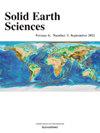Mesozoic magmatism and crustal evolution in the Xing’an–Mongolia Orogenic Belt, NE China
IF 2
4区 地球科学
Q3 GEOSCIENCES, MULTIDISCIPLINARY
引用次数: 0
Abstract
The Xing’an–Mongolia Orogenic Belt (XMOB), located in the eastern Central Asian Orogenic Belt (CAOB), is a critical area for understanding Phanerozoic crustal accretion and reworking. Its geological record reflects the combined influence of Paleozoic ocean closure and extensive Mesozoic overprinting linked to the subduction of the Mongol–Okhotsk and Paleo-Pacific plates. This study integrates published geochronological, geochemical, and zircon Hf isotopic data to investigate the spatiotemporal patterns and petrogenesis of Mesozoic magmatic rocks in the XMOB, focusing on the Ergun and Xing’an blocks. The results suggest that the region’s Mesozoic magmatism was primarily driven by tectonic transitions associated with the closure of the Mongol–Okhotsk Ocean and rollback of the Paleo-Pacific slab. Isotopic evidence reveals distinct crustal processes in the two blocks, with vertical crustal reworking dominating in the Ergun Block and lateral crustal growth in the Xing’an Block. These findings shed new light on the tectono-magmatic evolution of northeastern China and contribute to broader understanding of continental crustal development in the eastern CAOB.
兴蒙造山带中生代岩浆活动与地壳演化
兴蒙造山带(XMOB)位于中亚造山带(CAOB)东部,是认识显生宙地壳增生和改造的重要区域。其地质记录反映了古生代海洋闭合和与蒙古-鄂霍次克和古太平洋板块俯冲有关的中生代广泛叠印的综合影响。本研究结合已发表的年代学、地球化学和锆石Hf同位素数据,研究了XMOB中生代岩浆岩的时空格局和岩石成因,重点研究了二尔根和兴安地块。结果表明,该地区中生代岩浆活动主要受蒙古-鄂霍次克洋闭合和古太平洋板块回退相关的构造转变驱动。同位素证据显示两个地块的地壳作用过程明显,二根地块以垂直地壳改造为主,兴安地块以侧向地壳生长为主。这些发现对中国东北构造-岩浆演化有新的认识,有助于对中国东部大陆地壳发育有更广泛的认识。
本文章由计算机程序翻译,如有差异,请以英文原文为准。
求助全文
约1分钟内获得全文
求助全文
来源期刊

Solid Earth Sciences
GEOSCIENCES, MULTIDISCIPLINARY-
CiteScore
3.60
自引率
5.00%
发文量
20
审稿时长
103 days
 求助内容:
求助内容: 应助结果提醒方式:
应助结果提醒方式:


